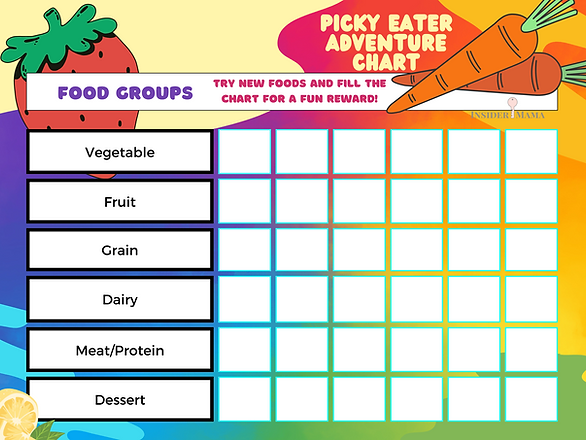There’s a phase in every parent’s life when you’ve prepared a colorful, nutritious meal, only for your little one to push the plate away and declare, “I’m not eating that!” Ah, the picky eater phase. If you’re nodding along, trust me, you’re not alone. As a mom of five who’s navigated these turbulent toddler and preschooler waters, I’m here to offer some insight and share a few tips to help bring some variety (and peace!) to your family table. This post is all about dealing with picky eaters.

This site contains affiliate links, please view the disclosure for more information.
Dealing with Picky Eaters and Incorporating Healthy Foods
1. Understanding the Picky Phase
It’s important to understand that being a picky eater is often a normal developmental stage. Around the age of two, many children become more cautious about what they eat. It’s a combination of asserting independence and their instinct to be wary of unfamiliar foods. So, deep breaths, mama. This too shall pass.
2. Start Small
Don’t overhaul your child’s diet overnight. Instead, introduce one new food at a time. Remember the first time little Jamie tried broccoli? He might’ve squirmed, but fast forward a few weeks, and he might just accept it as a regular on his plate.
3. Make Mealtime Fun
Turn mealtime into an enjoyable experience. Think colorful plates, fun shapes, or even renaming foods. Instead of ‘spinach,’ it’s ‘Hulk’s favorite power leaves.’ It’s all about making the unfamiliar, familiar.
I recently discovered the SpinMeal – a healthy nutrition plate designed especially for picky eaters. With a fun spin-the-arrow feature, it turns mealtime into a delightful game, making our kiddos excited about their meals.
4. Get Them Involved
Whether it’s letting them choose a vegetable during your grocery run or involving them in the cooking process, when kids feel they’ve had a say, they’re more likely to eat. My little Lacey was hesitant about bell peppers, but when she helped make her stuffed pepper “boat”, she couldn’t resist taking a bite.
5. Mix the New with the Known
If they love mashed potatoes but are unsure about carrots, try blending the two into a creamy carrot-potato mash. Familiar flavors can make new foods seem less intimidating.
6. Consistency is Key
It’s tempting to just give in and prepare mac ‘n cheese for the umpteenth time, but consistency is essential. Even if they refuse a particular food, reintroduce it in a week or so. Sometimes, it can take multiple exposures before a child accepts a new food.

7. Educate Them
Make learning about foods a part of their world. There are countless children’s books about vegetables, fruits, and healthy eating. When they understand where their food comes from and its benefits, they might be more willing to try it.
8. Lead by Example
Kids are little mimics. If they see you relishing your greens, they might just be tempted to try some too. I wasn’t a big cooked vegetable eater, but when I noticed our son picking up on that, I started incorporating more cooked veggies into my diet. The result? A more veggie-friendly household!
9. Sneak Veggies In
While it’s important for kids to see and appreciate whole veggies, sometimes you gotta do what you gotta do. Veggie-packed smoothies, zucchini in muffins, or spinach in their scrambled eggs can be a good way to ensure they get those nutrients.
10. Avoid Making Separate Meals
It’s tempting to become a short-order cook, but it’s not sustainable. Prepare one meal for the family. If they don’t eat it, gently remind them that it’s what’s for dinner. It establishes a precedent that mealtimes are not negotiable feasts based on individual whims.
11. Create a Positive Environment
Make sure that mealtime is a stress-free time. If they don’t eat their greens today, there’s always tomorrow. Avoid turning it into a battle. A positive experience is more likely to have them come back to the table with an open mind.
12. Seek Out Peer and Friend Influence
Sometimes, seeing their peers enjoy certain foods can make your child more willing to try them. Playdates or group lunches can often be a great way to introduce them to a variety of foods.
13. Praise Their Tasting Adventures
Every time your child tries something new, even if it’s just a nibble, praise them for it. Let them know how proud you are of their adventurous spirit. My daughter’s face lights up every time I tell her she’s my “brave taster”.
I know from experience how hard it can be to get our kids to try new foods and how much we want their plates to be full of a rainbow of healthy foods. So, I made the “Picky Eater Adventure Chart“, especially for you. It’s a fun, colorful tool that will add a pop of color to your kitchen and get your kids excited about trying new things in the kitchen. Also, this chart will remind you every day of the small wins you’re making on this food journey together.
So why hold out? Download the chart, get ready for a journey, and let’s make mealtimes more fun and memorable. Together, we can make eating healthy a fun adventure!

14. Use Dips and Sauces
If your child shies away from raw veggies, sometimes a fun dip can change their perspective. Hummus, yogurt-based dips, or even a little cheese sauce can make those veggies more palatable.
15. Set Regular Meal and Snack Times
Routine helps. When kids know when to expect their meals, they’re more likely to be hungry and ready to eat. Plus, avoiding random snacking ensures they approach meals with an appetite.
16. Grow Foods Together
If you have even a tiny bit of outdoor space (or even indoors with pots), try growing some vegetables or herbs together. The excitement of seeing something grow from a tiny seed often translates into an eagerness to taste. Our little balcony garden yielded some tomatoes last summer, and the joy on my son’s face when he bit into one he helped grow was priceless.
17. Allow for Some Autonomy
Let them make choices. Ask, “Would you like carrots or beans tonight?” This gives them a feeling of control, without straying from the healthy options you want them to eat.
18. Keep the Junk Out of Sight
Children (and let’s be honest, even us adults!) are more likely to grab unhealthy snacks if they’re easily accessible. Keep fruits on the counter, pre-cut veggies at eye level in the fridge, and those cookies and chips out of immediate sight.
19. Be Compassionate
It’s easy to get frustrated, but remember, these little humans are navigating a world of flavors and textures. Sometimes it’s about taste, and texture, and sometimes it’s just about asserting independence. Approach their hesitations with understanding and empathy.
20. Seek Feedback and Adjust
Ask your kids what they liked or didn’t like about a particular dish. Maybe it’s too crunchy, too soft, too spicy. Their feedback can help you adjust and prepare it differently next time.
Dealing with Picky Eaters: How a Foodie Mom Uses a Food Journal to Crack the Code
Remember jotting down notes about childhood crushes and dramatic third-grade events? Well, it’s diary time once more! Only now, we’re tracking the delicious (and occasionally not-so-delicious) meals our kids are sampling. Welcome to the world of food journals, your secret weapon in dealing with picky eaters!
“Why Do I Need a Food Journal?” I Hear You Ask.
Imagine having a magical book that tells you exactly which foods make your kiddo’s face light up like it’s Christmas, and which ones they push around their plate pretending they’ve suddenly turned vegetarian. That, my friend, is a food journal!
Benefits of Keeping a Food Journal:
- Detective Mom on the Case: Ever wondered if there’s a pattern to those picky eating days? Maybe it’s every Wednesday because of school lunch? Or every time they eat that fancy gluten-free bread? A food journal can help you spot these clues!
- No More Guessing Games: Remember the “Do you like this? How about this?” game? Now, you’ll know their favorites, their sometimes-foods, and the absolute no-nos.
- Spot Those Sneaky Allergies: Itchy skin after strawberries? Or a tiny rash after peanuts? Keeping track helps you quickly notice if something’s up and when to chat with the doc.
- Victory Dances & Happy Dances: Celebrate when they try something new! And if they liked it? Well, that’s a double dance day!
- Kiddo Involvement: Let them put fun stickers or draw on the food journal. They’ll feel so grown-up!

Final Thoughts on Dealing with Picky Eaters
Getting your picky eaters to try new foods isn’t always smooth sailing, but it’s a great opportunity to bond, teach, and watch them grow. With some creative thinking and a good dose of patience, we can guide our kids towards healthier eating habits. It’s not about creating flawless eaters. Our aim is to help them appreciate food that tastes great and is good for them too.



